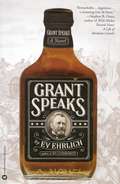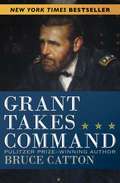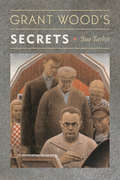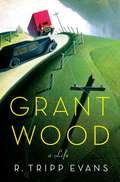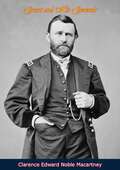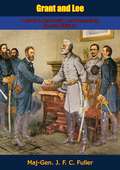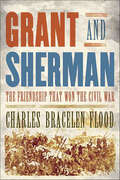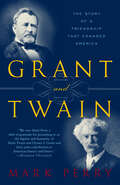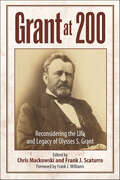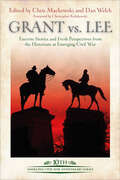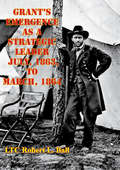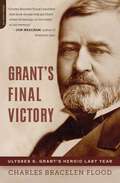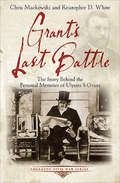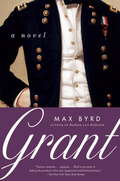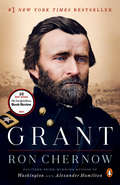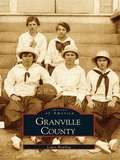- Table View
- List View
Grant Speaks
by Ev EhrlichWhether putting Generals Burnside, Hooker, and Robert E. Lee in their place, or listening to foul-mouthed General Sherman, Hiram Ulysses S. 'Useless' Grant offers an amusingly warped perspective on the Civil War.
Grant Takes Command: Grant Moves South And Grant Takes Command
by Bruce CattonA thrilling account of the final years of the War Between the States and the great general who led the Union to victory This conclusion of Pulitzer Prize-winning author Bruce Catton's acclaimed Civil War history of General Ulysses S. Grant begins in the summer of 1863. After Grant's bold and decisive triumph over the Confederate Army at Vicksburg--a victory that wrested control of the Mississippi River from Southern hands--President Abraham Lincoln promoted Grant to the head of the Army of the Potomac. The newly named general was virtually unknown to the nation and to the Union's military high command, but he proved himself in the brutal closing year and a half of the War Between the States. Grant's strategic brilliance and unshakeable tenacity crushed the Confederacy in the battles of the Overland Campaign in Virginia and the Siege of Petersburg. In the spring of 1865, Grant finally forced Robert E. Lee's surrender at Appomattox Court House, thus ending the bloodiest conflict on American soil. Although tragedy struck only days later when Lincoln--whom Grant called "incontestably the greatest man I have ever known"--was assassinated, Grant's military triumphs would ensure that the president's principles of unity and freedom would endure. In Grant Takes Command, Catton offers readers an in-depth portrait of an extraordinary warrior and unparalleled military strategist whose brilliant battlefield leadership saved an endangered Union.
Grant Wood's Secrets
by Sue TaylorIncorporating copious archival research and original close readings of American artist Grant Wood’s iconic as well as lesser-known works, Grant Wood’s Secrets reveals how his sometimes anguished psychology was shaped by his close relationship with his mother and how he channeled his lifelong oedipal guilt into his art. Presenting Wood’s abortive autobiography "Return from Bohemia" for the first time ever, Sue Taylor integrates the artist’s own recollections into interpretations of his art. As Wood dressed in overalls and boasted about his beloved Midwest, he consciously engaged in regionalist strategies, performing a farmer masquerade of sorts. In doing so, he also posed as conventionally masculine, hiding his homosexuality from his rural community. Thus, he came to experience himself as a double man. This book conveys the very real threats under which Wood lived and pays tribute to his resourceful responses, which were often duplicitous and have baffled art historians who typically take them at face value.
Grant Wood: A Life
by R. Tripp EvansA major new biography of America’s most acclaimed, and misunderstood, regionalist painter, Grant Wood who is revealed to have been anything but plain, or simple . . . R. Tripp Evans reveals the true complexity of the man and the image Wood so carefully constructed of himself. Grant Wood called himself a farmer-painter but farming held little interest for him. He appeared to be a self-taught painter with his scenes of farmlands, farm workers, and folklore but he was classically trained, a sophisticated artist who had studied the Old Masters and Flemish art as well as impressionism. He lived a bohemian life and painted in Paris and Munich in the 1920s, fleeing what H. L. Mencken referred to as “the booboisie” of small-town America. We see Wood as an artist haunted and inspired by the images of childhood; by the complex relationship with his father (stern, pious, the “manliest of men”); with his sister and his beloved mother (Wood shared his studio and sleeping quarters with his mother until her death at seventy-seven; he was forty-four). We see Wood’s homosexuality and how his studied masculinity was a ruse that shaped his work. Here is Wood’s life and work explored more deeply and insightfully than ever before. Drawing on letters, the artist’s unfinished autobiography, his sister’s writings, and many never-before-seen documents, Evans’s book is a dimensional portrait of a deeply complicated artist who became a “National Symbol. ” It is as well a portrait of the American art scene at a time when America’s Calvinistic spirit and provincialism saw Europe as decadent and artists were divided between red-blooded patriotic men and “hothouse aesthetes. ” Thomas Hart Benton said of Grant Wood: “When this new America looks back for landmarks to help gauge its forward footsteps, it will find a monument standing up in the midst of the wreckage . . . This monument will be made out of Grant Wood’s works. ”
Grant and His Generals
by Clarence Edward Noble MacartneyBased on 40 years of research on the Civil War, this book portrays little-known, but dramatic events incident to General Ulysses Grant's leadership of the Union armies.Grant’s Civil War career is a bright parenthesis in a long paragraph of failure. He failed as an officer in the old army; not indeed in the Mexican War itself, but thereafter, when he left the army under a cloud. He failed as a farmer; as a real-estate agent; in the opinion of many, as a President; and as a banker. But from Belmont to Appomattox, meeting and defeating one after another the ablest generals the South could pit against him, from Albert Sidney Johnston to Robert E. Lee, he enjoyed an unbroken record of victory and success.That success has puzzled many a student. How shall we account for it? Badeau, Grant’s military secretary, said that neither he nor the other members of the staff knew why Grant succeeded. They believed in him “because of his success.” Perhaps Sherman approached as nearly as anyone the secret; writing to Grant after he had been appointed lieutenant-general and commander of all the armies, he said: “The chief characteristic of your nature is the simple faith in success you have always manifested, which I can liken to nothing else than the faith a Christian has in his Saviour.”A great personality always embodies intangibles which elude classification and baffle definition. Undoubtedly, one of the best ways to study Grant and penetrate to the heart and mind of this in many ways inscrutable character is to regard him in the light of his personal and military association with the leading officers who labored with him.
Grant and Lee: A Study in Personality and Generalship [Second Edition]
by Maj.-Gen J. F. C. FullerFirst published in 1957, this second edition of the analysis of the generalship of Ulysses S. Grant and Robert E. Lee remains one of the most readable histories of the Civil War. The author began his research sharing the generally held assumption that Lee was a great general and Grant a clumsy “butcher.” By the time Fuller completed his project, however, he regarded Grant as the greatest general of his age and one of the greatest strategists of any age. Grant and Lee is a compelling study not only of two remarkable men but also of the nature of leadership and command in wartime.“...cuts squarely across the accepted tradition...[Fuller] examines these two great soldiers from a fresh viewpoint and refuses to let himself be bound by tradition.”—Bruce Catton, New York Times Book Review“...a stimulating study which appreciates both the unique personalities of the protagonists and the social conditions which stamped their tactics.”—Commonweal“Fuller’s...analysis and comparison of the personality, leadership, and generalship of Grant and Lee is as readable, instructive, stimulating, and...controversial as when first published.”—Military Review
Grant and Sherman: The Friendship That Won the Civil War
by Charles Bracelen FloodThis dual Civil War biography presents “[a] powerful and illuminating study of a military collaboration that won the war for the Union” (Josiah Bunting III, Washington Post).“We were as brothers,” William Tecumseh Sherman said, describing his relationship to Ulysses S. Grant. They were incontestably two of the most important figures in the Civil War, but until now there has been no book about their victorious partnership and the deep friendship that made it possible.They were prewar failures: Grant was forced to resign from the Regular Army because of his drinking, and Sherman had moved from one job to the next in the years before the conflict. But heeding the call to save the Union, each struggled past political hurdles to join the war effort. And after taking each other’s measure at the Battle of Shiloh, they began their unique collaboration.Often together under fire on the war’s great battlefields, they also supported each other in the face of mudslinging criticism by the press and politicians. Sharing the demands of family life and the heartache of loss, they built a mutual admiration and trust which President Lincoln increasingly relied upon. Though their headquarters were hundreds of miles apart, they communicated almost daily, strategizing the final moves of the war and planning how to win the peace that would follow.
Grant and Temperley's Europe in the Nineteenth Century 1789-1905
by Arthur James Grant Agatha Ramm H.W.V. TemperleyThis seventh edition of 'Grant and Temperley' has been comprehensively revised and rewritten by the distinguished historian Agatha Ramm. Its coverage has been greatly extended , and it now appears in two volume. This, volume one, covers the nineteenth century 1789-1905 and the second the period 1905-1970.
Grant and Temperley's Europe in the Twentieth Century 1905-1970
by Arthur James Grant H.W.V. Temperley Agatha RammThis introductory survey covers all aspects of the period when Britain was transformed into an industrial, urban society, with political power in the hands of the middle class.
Grant and Twain: The Story of a Friendship That Changed America
by Mark PerryIn the spring of 1884 Ulysses S. Grant heeded the advice of Mark Twain and finally agreed to write his memoirs. Little did Grant or Twain realize that this seemingly straightforward decision would profoundly alter not only both their lives but the course of American literature. Over the next fifteen months, as the two men became close friends and intimate collaborators, Grant raced against the spread of cancer to compose a triumphant account of his life and times—while Twain struggled to complete and publish his greatest novel, Adventures of Huckleberry Finn. In this deeply moving and meticulously researched book, veteran writer Mark Perry reconstructs the heady months when Grant and Twain inspired and cajoled each other to create two quintessentially American masterpieces. In a bold and colorful narrative, Perry recounts the early careers of these two giants, traces their quest for fame and elusive fortunes, and then follows the series of events that brought them together as friends. The reason Grant let Twain talk him into writing his memoirs was simple: He was bankrupt and needed the money. Twain promised Grant princely returns in exchange for the right to edit and publish the book—-and though the writer’s own finances were tottering, he kept his word to the general and his family. Mortally ill and battling debts, magazine editors, and a constant crush of reporters, Grant fought bravely to get the story of his life and his Civil War victories down on paper. Twain, meanwhile, staked all his hopes, both financial and literary, on the tale of a ragged boy and a runaway slave that he had been unable to finish for decades. As Perry delves into the story of the men’s deepening friendship and mutual influence, he arrives at the startling discovery of the true model for the character of Huckleberry Finn. With a cast of fascinating characters, including General William T. Sherman, William Dean Howells, William Henry Vanderbilt, and Abraham Lincoln, Perry’s narrative takes in the whole sweep of a glittering, unscrupulous age. A story of friendship and history, inspiration and desperation, genius and ruin, Grant and Twain captures a pivotal moment in the lives of two towering Americans and the age they epitomized.
Grant at 200: Reconsidering the Life and Legacy of Ulysses S. Grant
by Chris Mackowski Frank J. ScaturroProceeds from this volume will go to support the Ulysses S. Grant Association and the Grant Monument Association. Ulysses S. Grant stood at the center of the American Civil War maelstrom. The Ohio native answered his nation’s call to service and finished the war as a lieutenant general in command of the U.S. Army. Four years later, he ascended to the presidency to better secure the peace he had helped win on the battlefield. Despite his major achievements in war and peace, political and sectional enemies battered his reputation. For nearly a century, his military and political career remained deeply misunderstood. Since the Civil War centennial, however, Grant’s reputation has blossomed into a full renaissance. His military record garners new respect and, more recently, an appreciation for his political career—particularly his strong advocacy for equal rights—is quickly catching up. Throughout these decades, his personal memoirs marking him as a significant American “Man of Letters” have never gone out of print. Grant at 200: Reconsidering the Life and Legacy of Ulysses S. Grant celebrates the bicentennial of the birth of a man whose towering impact on American history has often been overshadowed and, in many cases, ignored. This collection of essays by some of today’s leading Grant scholars offers fresh perspectives on Grant’s military career and presidency, as well as underexplored personal topics such as his faith and family life.
Grant vs. Lee: Favorite Stories and Fresh Perspectives from the Historians at Emerging Civil War
by Chris MackowskiWith the presidential election looming in the fall, President Abraham Lincoln needed to break the deadlock. To do so, he promoted Ulysses S. Grant—the man who had strung together victory after victory in the Western Theater, including the capture of two entire Confederate armies. The unassuming “dust-covered man” was now in command of all the Union armies, and he came east to lead them. The unlucky soldiers of George G. Meade’s Army of the Potomac had developed a grudging respect for their Southern adversary and assumed a wait-and-see attitude: “Grant,” they reasoned, “has never met Bobby Lee yet.” By the spring of 1864, Robert E. Lee, the commander of the Army of Northern Virginia, had come to embody the Confederate cause. Grant knew as much and decided to take the field with the Potomac army. He ordered his subordinates to forego efforts to capture the capital of Richmond in favor of annihilating Lee’s command. Grant’s directive to General Meade was straightforward: “Where Lee goes, there you will go also.” Lee and Grant would come to symbolize the armies they led when the spring 1864 campaign began in northern Virginia in the Wilderness on May 5, 1864. What followed was a desperate and bloody death match that ran through the long siege of Richmond and Petersburg before finally ending at Appomattox Court House eleven months later—but at what cost along the way? Grant vs. Lee: Favorite Stories and Fresh Perspectives from the Historians at Emerging Civil War recounts some of the most famous episodes and compelling human dramas from the marquee matchup of the Civil War. These expanded and revised essays also commemorate a decade of Emerging Civil War, a “best of” collection on the Overland Campaign, the siege of Petersburg, and the Confederate surrender at Appomattox.
Grant's Emergence As A Strategic Leader July, 1863, To March, 1864
by LTC Robert L. BallThis paper looks at Ulysses S. Grant's development as a strategic leader with emphasis on the time period July, 1863, to March, 1864. It has a dual focus. The first is an examination of Grant's growth as a strategic thinker. The second is on the opening of opportunity for Grant to become a leader at the strategic level. The paper is written chronologically, with both subjects interwoven.Bruce Catton, Lloyd Lewis, Carl Sandburg, and T. Harry Williams wrote the primary sources used in research and provided a good balance of "Grant-centric" and "Lincoln-centric" views. Whenever possible, The Official Records of the Rebellion were used. Care was taken to use source material written during the Civil War. Sherman's war time views of Grant's abilities carry more weight in this paper than what he wrote after the war. Similarly, Grant's Memoirs were read with a jaundiced eye.The findings of the research are laid out in the body of the paper. Grant's career is reviewed in order to show a steady progression of ability. There is also a noticeable maturation in Grant's strategic thinking that can be seen in the period highlighted. Finally, incidents are examined in which Grant proved himself to President Lincoln to be a perceptive, adept actor in the politics of high level command, earning Lincoln's trust and confidence.The conclusion of the paper is that just when the nation called for him, Grant had developed the essential skills for the job of general-in-chief.
Grant's Final Victory: Ulysses S. Grant's Heroic Last Year
by Charles Bracelen FloodCivil War General Ulysses S. Grant completed his now-famous memoir as he fought against his final illness, in the hope that profits from the book would support his family after he was swindled by a business partner. This book details the public support surrounding Grant as he rushed to finish the book before his death and describes the roles of family, friends, and physicians, especially Grant's friend and publisher Mark Twain. The book is illustrated with b&w historical photos. Flood is past president of PEN American Center. Annotation ©2011 Book News, Inc. , Portland, OR (booknews. com)
Grant's Last Battle: The Story Behind the Personal Memoirs of Ulysses S. Grant (Emerging Civil War Series)
by Chris Mackowski Kristopher D. WhiteThe remarkable story of how one of America’s greatest military heroes became a literary legend. The former general in chief of the Union armies during the Civil War . . . the two-term president of the United States . . . the beloved ambassador of American goodwill around the globe . . . the respected New York financier—Ulysses S. Grant—was dying. The hardscrabble man who regularly smoked twenty cigars a day had developed terminal throat cancer. Thus began Grant’s final battle—a race against his own failing health to complete his personal memoirs in an attempt to secure his family’s financial security. But the project evolved into something far more: an effort to secure the very meaning of the Civil War itself and how it would be remembered. In this maelstrom of woe, Grant refused to surrender. Putting pen to paper, the hero of Appomattox embarked on his final campaign: an effort to write his memoirs before he died. The Personal Memoirs of Ulysses S. Grant would cement his place as not only one of America’s greatest heroes but also as one of its most sublime literary voices. Authors Chris Mackowski and Kristopher D. White have recounted Grant’s battlefield exploits as historians at Fredericksburg and Spotsylvania National Military Park, and Mackowski, as an academic, has studied Grant’s literary career. Their familiarity with the former president as a general and as a writer bring Grant’s Last Battle to life with new insight, told with the engaging prose that has become the hallmark of the Emerging Civil War Series.
Grant's Tomb: The Epic Death of Ulysses S. Grant and the Making of an American Pantheon
by Louis L. PiconeThe moving story of Ulysses S. Grant's final battle, and the definitive account of the national memorial honoring him as one of America's most enduring heroes The final resting place of Ulysses S. Grant, the victorious general in the Civil War and the eighteenth president of the United States, is a colossal neoclassical tomb located in the most dynamic city in the country. It is larger than the final resting place of any other president or any other person in America. Since its creation, the popularity and condition of this monument, built to honor the man and what he represented to a grateful nation at the time of his death, a mere twenty years after the end of the Civil War, have reflected not only Grant's legacy in the public mind but also the state of New York City and of the Union.In this fascinating, deeply researched book, presidential historian Louis L. Picone recounts the full story. He begins with Grant's heroic final battle during the last year of his life, to complete his memoirs in order to secure his family's financial future while contending with painful, incurable cancer. Grant accomplished this just days before his death, and his memoirs, published by Mark Twain, became a bestseller. Accompanying his account with numerous period photographs, Picone narrates the national response to Grant's passing and how his tomb came to be: the intense competition to be the resting place for Grant's remains, the origins of the memorial and its design, the struggle to finance and build it over the course of twelve years, and the vicissitudes of its afterlife in the history of the nation up to recent times.
Grant: A Biography (Great Generals Series)
by John MosierGrant: A Biography tells of the extraordinary life and legacy of one of America's most ingenious military mindsA modest and unassuming man, Grant never lost a battle, leading the Union to victory over the Confederacy during the Civil War, ultimately becoming President of the reunited states. Grant revolutionized military warfare by creating new leadership tactics by integrating new technologies in classical military strategy. In this compelling biography, John Mosier reveals the man behind the military legend, showing how Grant's creativity and genius off the battlefield shaped him into one of our nation's greatest military leaders.
Grant: A Novel
by Max ByrdMax Byrd, the renowned author of Jackson and Jefferson, brings history to life in this stunning novel set in America's Gilded Age. Grant is an unforgettable portrait of a colorful era--and the flawed, iron-willed, mysterious giant at its center. Ulysses S. Grant pursued a tragic war to its very end. But his final battle starts in 1880, when he loses his race to become the first U.S. President to serve three terms, goes bankrupt, and begins a fight against cancer that will prove to be his greatest challenge. Through journalist Nicholas Trist, readers follow Grant's journey--and along the way meet Grant's sworn enemy Henry Adams and Adams's doomed wife, Clover, the old soldiers Sherman and Sheridan, and the always clever, always scheming Mark Twain. Revealed here are not only the penetrating secrets of our eighteenth president, but the intimate power-brokering that led to the end of Grant's career, setting the stage for a new era in American history--one defined by politics, not warfare. "Serious, intricate . . . gripping . . . Byrd is an expert at linking the products of his own imagination with historical facts."--The New York Times Book Review "With the license and gifts of a first-rate novelist, Max Byrd has managed in Grant to reveal the man far better than those who have tried before."--San Francisco Chronicle "A vibrant, stunning story of Grant's last years, but best of all, a gripping tale of 'the reborn nation on the other side of the war.' "--Civil War Book Review "Splendid . . . nothing less than a visit with greatness."--Associated Press "Historical fiction doesn't get any better than this."--Booklist
Grant: The Wartime Letters Of Ulysses S. Grant To His Wife
by Ron Chernow<P>Pulitzer Prize winner Ron Chernow returns with a sweeping and dramatic portrait of one of our most compelling generals and presidents, Ulysses S. Grant. <P>Ulysses S. Grant's life has typically been misunderstood. All too often he is caricatured as a chronic loser and an inept businessman, or as the triumphant but brutal Union general of the Civil War. But these stereotypes don't come close to capturing him, as Chernow shows in his masterful biography, the first to provide a complete understanding of the general and president whose fortunes rose and fell with dizzying speed and frequency. Before the Civil War, Grant was flailing. <P>His business ventures had ended dismally, and despite distinguished service in the Mexican War he ended up resigning from the army in disgrace amid recurring accusations of drunkenness. But in war, Grant began to realize his remarkable potential, soaring through the ranks of the Union army, prevailing at the battle of Shiloh and in the Vicksburg campaign, and ultimately defeating the legendary Confederate general Robert E. Lee. Along the way, Grant endeared himself to President Lincoln and became his most trusted general and the strategic genius of the war effort. Grant’s military fame translated into a two-term presidency, but one plagued by corruption scandals involving his closest staff members. <P>More important, he sought freedom and justice for black Americans, working to crush the Ku Klux Klan and earning the admiration of Frederick Douglass, who called him “the vigilant, firm, impartial, and wise protector of my race.” After his presidency, he was again brought low by a dashing young swindler on Wall Street, only to resuscitate his image by working with Mark Twain to publish his memoirs, which are recognized as a masterpiece of the genre. <P> With lucidity, breadth, and meticulousness, Chernow finds the threads that bind these disparate stories together, shedding new light on the man whom Walt Whitman described as “nothing heroic... and yet the greatest hero.” Chernow’s probing portrait of Grant's lifelong struggle with alcoholism transforms our understanding of the man at the deepest level. This is America's greatest biographer, bringing movingly to life one of our finest but most underappreciated presidents. The definitive biography, <i>Grant</i> is a grand synthesis of painstaking research and literary brilliance that makes sense of all sides of Grant's life, explaining how this simple Midwesterner could at once be so ordinary and so extraordinary. <P><b>A New York Times Bestseller</b>
Grant’s Campaign in Virginia (Special Campaigns Series #8)
by Captain Vaughan-SawyerThis ebook is purpose built and is proof-read and re-type set from the original to provide an outstanding experience of reflowing text for an ebook reader. Includes Civil War Map and Illustrations Pack - 224 battle plans, campaign maps, and detailed analyses of actions spanning the entire period of hostilities. The high-tide of Confederate success had passed with Pickett's charge at the battle of Gettysburg; the Union armies were re-invigorated by fresh leadership under Lieut.-General U.S. Grant, who decided upon a campaign that was to push toward the Confederate capital of Virginia through Spotsylvania. The area over which Grant intended to advance was sparsely populated, inaccessible and densely wooded, and his troops' numerical superiority could only be used in the few open areas for a general action. Grant knew that his troops would have to move in separate columns, if only to concentrate for concerted action. General Lee moved to attack the Union troops as they moved into position, before the numerical advantage in open country would spell doom to Confederate hopes. The fighting was confused and bloody; but despite the losses of the Union army, which exceeded the losses of the Confederates greatly, Grant ground onward for he knew that he could afford the casualties better than his enemy. This book is part of the Special Campaigns series produced around the turn of the 20th century by serving or recently retired British and Indian Army officers. They were intended principally for use by British officers seeking a wider knowledge of military history. Captain Vaughan-Sawyer served in the Indian army for all his adult life before falling in the opening months of the First World War. His excellent book is evidence of a life cut short. Title - Grant's Campaign in Virginia (The Wilderness Campaign) 1864 Author -- Captain Vaughan-Sawyer (1875-1914) Series Name - Special Campaigns Series Series Number --8 Text taken, whole and complete, from the edition published in 1908, London, by Swan Sonnenschein & Co. Original -197 pages. Illustrations -- The maps cannot be reproduced with this volume as they are A3 - 224 additional maps have been added.
Grant’s Left Hook: The Bermuda Hundred Campaign, May 5–June 7, 1864 (Emerging Civil War Series)
by Sean ChickRobert E. Lee feared the day the Union army would return up the James River and invest the Confederate capital of Richmond. In the spring of 1864, Ulysses Grant, looking for a way to weaken Lee, was about to exploit the Confederate commander’s greatest fear and weakness. After two years of futile offensives in Virginia, the Union commander set the stage for a campaign that could decide the war. Grant sent the 38,000-man Army of The James to Bermuda Hundred, to threaten and possibly take Richmond, or at least pin down troops that could reinforce Lee. Jefferson Davis, in desperate need of a capable commander, turned to the Confederacy’s first hero: Pierre Gustave Toutant Beauregard. Butler’s 1862 occupation of New Orleans had infuriated the South, but no one more than Beauregard, a New Orleans native. This campaign would be personal. In the hot weeks of May 1864, Butler and Beauregard fought a series of skirmishes and battles to decide the fate of Richmond and Lee’s army. Historian Sean Michael Chick analyzes and explains the plans, events, and repercussions of the Bermuda Hundred Campaign in Grant’s Left Hook: The Bermuda Hundred Campaign, May 5-June 7, 1864. The book contains hundreds of photographs, new maps, and a fresh consideration of Grant’s Virginia strategy and the generalship of Butler and Beauregard. The book is also filled with anecdotes and impressions from the rank and file who wore blue and gray.
Granville County: Looking Back (Images of America)
by Lewis BowlingNorth Carolina's historic county of Granville, nestled in the rolling hills of the Piedmont along the North Carolina-Virginia border, was named for Lord John Carteret, Earl of Granville, in the mid-18th century. The home to Declaration of Independence signer John Penn, Granville was once recognized for its educational centers and tobacco-based economy. Although the county has become more industrial than agricultural in recent years, Granvillians hold fast to their rural heritage, honoring and remembering the hardships early settlers triumphantly faced to mold a better life for both themselves and future generations.Images of America: Granville County is a pictorial retrospective illustrating many of the county's achievements, both large and small. Vintage photographs, highlighted by informative captions, relay the arrival of the railroad and the towns of Creedmoor, Stem, and Stovall, which grew up along the tracks; the development of Oxford, the county seat; the construction and usage of Camp Butner; and various other events from the late 19th and 20th centuries. Images also feature past residents, offering longtime families the chance to see loved ones and newcomers the opportunity to connect faces with local names.
Granville Sharp's Uncovered Letter and the Zong Massacre
by Michelle FaubertThis book delineates the discovery of a previously unknown manuscript of a letter from Granville Sharp, the first British abolitionist, to the “Lords Commissioners of the Admiralty.” In the letter, Sharp demands that the Admiralty bring murder charges against the crew of the Zong for forcing 132 enslaved Africans overboard to their deaths. Uncovered by Michelle Faubert at the British Library in 2015, the letter is reproduced here, accompanied by her examination of its provenance and significance for the history of slavery and abolition. As Faubert argues, the British Library manuscript is the only fair copy of Sharp’s letter, and extraordinary evidence of Sharp’s role in the abolition of slavery.
Grape And Canister: The Story Of The Field Artillery Of The Army Of The Potomac, 1861 To 1865
by L. Vanloan NaisawaldIncludes - 18 maps and 6 illustrations"The role of the field artillery in the Civil War is often overlooked in favor of the more romantic views of great cavalry commanders or infantrymen. But the reality was that without the field artillery, many of the decisive battles won by the Army of the Potomac most likely would have resulted in defeat and/or destruction. Grape and Canister, first published in 1960, has since become a classic and remains the definitive study of the field artillery of the Army of the Potomac."-Print ed.
Grapes Of Wrath
by Boyd CableIT is possible that this book may be taken for an actual account of the Somme battle, but I warn readers that although it is in the bulk based on the fighting there and is no doubt colored by the fact that the greater part of it was written in the Somme area or between visits to it, I make no claim for it as history or as an historical account. My ambition was the much lesser one of describing as well as I could what a Big Push is like from the point of view of an ordinary average infantry private, of showing how much he sees and knows and suffers in a, great battle, of giving a glimpse perhaps of the spirit that animates the New Armies, the endurance that has made them more than a match for the Germans, the acceptance of appalling and impossible horrors as the work-a-day business and routine of battle, the discipline and training that has fused such a mixture of material into tempered fighting metal.For the tale itself, I have tried to put into words merely the sort of story that might and could be told by thousands of our men to-day. I hope, in fact, I have so "told the tale" that such men as I have written of may be able to put this book in your hands and say: "This chapter just describes our crossing the open," or "That is how we were shelled," or "I felt the same about my Blighty one."
